sensor MAZDA MODEL 6 2017 Owners Manual (in English)
[x] Cancel search | Manufacturer: MAZDA, Model Year: 2017, Model line: MODEL 6, Model: MAZDA MODEL 6 2017Pages: 578, PDF Size: 54.72 MB
Page 31 of 578
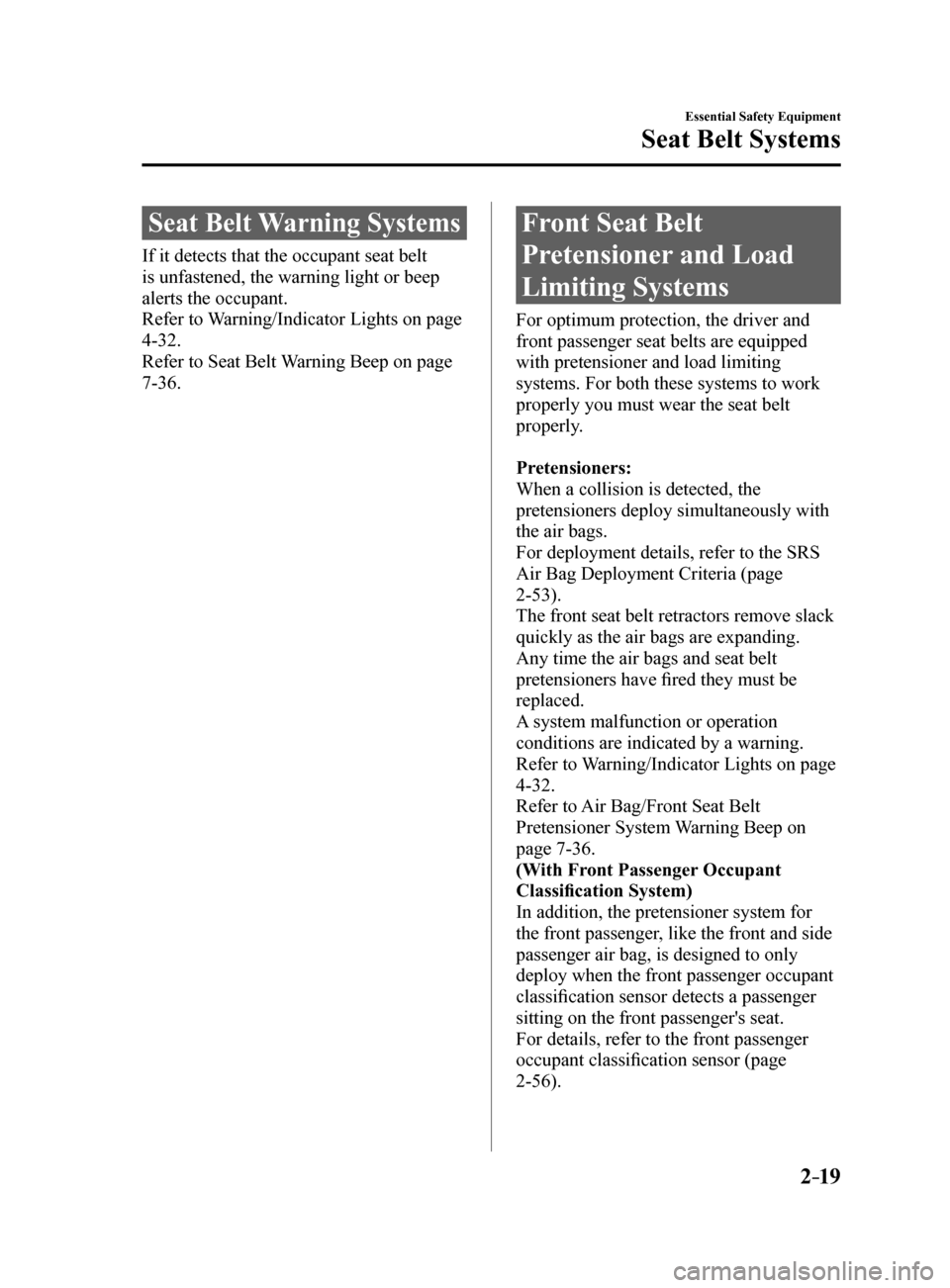
2–19
Essential Safety Equipment
Seat Belt Systems
Seat Belt Warning Systems
If it detects that the occupant seat belt
is unfastened, the warning light or beep
alerts the occupant.
Refer to Warning/Indicator Lights on page
4-32.
Refer to Seat Belt Warning Beep on page
7-36.
Front Seat Belt
Pretensioner and Load
Limiting Systems
For optimum protection, the driver and
front passenger seat belts are equipped
with pretensioner and load limiting
systems. For both these systems to work
properly you must wear the seat belt
properly.
Pretensioners:
When a collision is detected, the
pretensioners deploy simultaneously with
the air bags.
For deployment details, refer to the SRS
Air Bag Deployment Criteria (page
2-53).
The front seat belt retractors remove slack
quickly as the air bags are expanding.
Any time the air bags and seat belt
pretensioners have fired they must be
replaced.
A system malfunction or operation
conditions are indicated by a warning.
Refer to Warning/Indicator Lights on page
4-32.
Refer to Air Bag/Front Seat Belt
Pretensioner System Warning Beep on
page 7-36.
(With Front Passenger Occupant
Classification System)
In addition, the pretensioner system for
the front passenger, like the front and side
passenger air bag, is designed to only
deploy when the front passenger occupant
classification sensor detects a passenger
sitting on the front passenger's seat.
For details, refer to the front passenger
occupant classification sensor (page
2-56).
Mazda6_8FH2-EA-16F_Edition2.indb 192016/07/07 13:44:13
Page 35 of 578
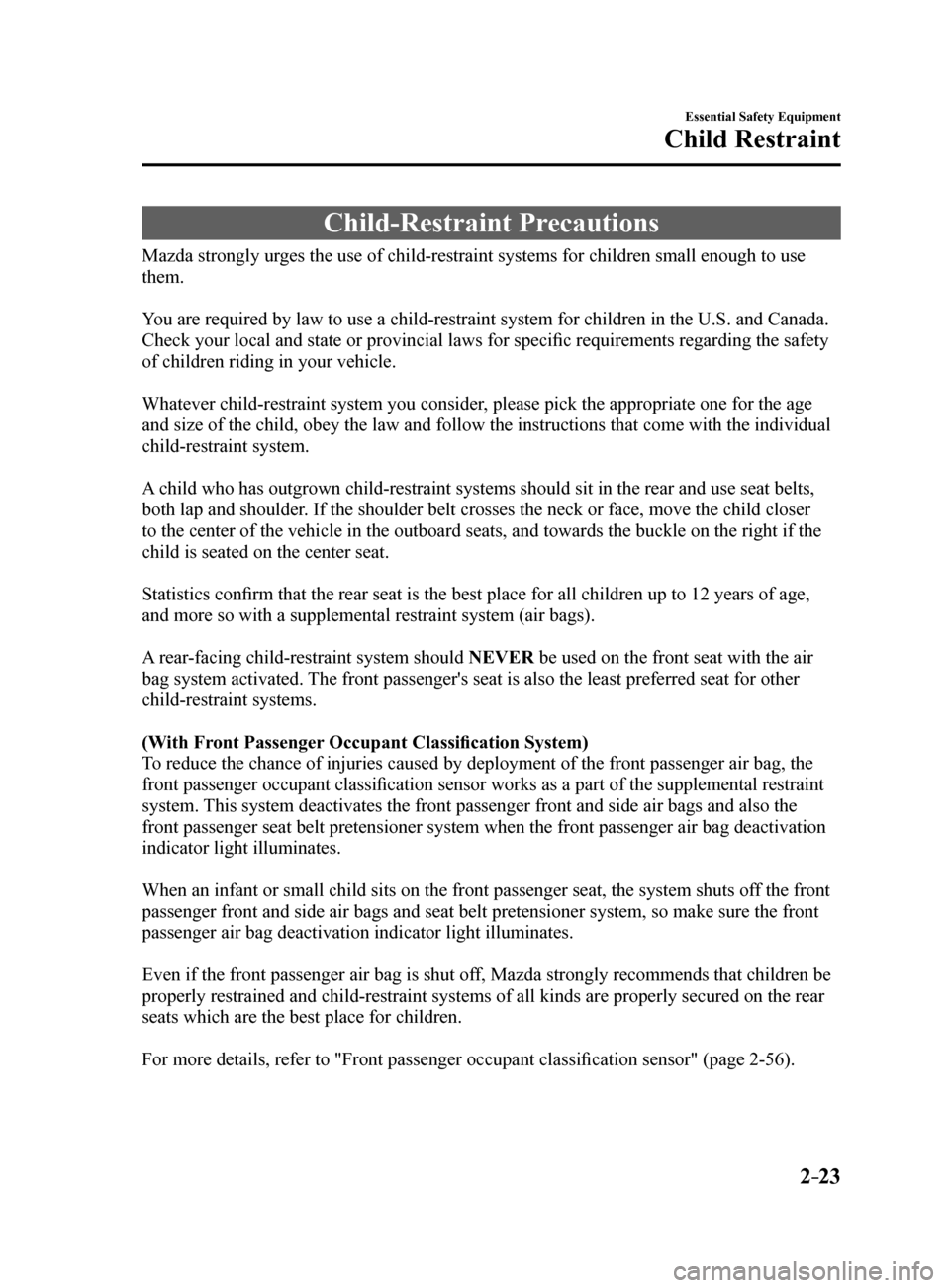
2–23
Essential Safety Equipment
Child Restraint
Child-Restraint Precautions
Mazda strongly urges the use of child-restraint systems for children small enough to use \
them.
You are required by law to use a child-restraint system for children in the U.S. and Canada.
Check your local and state or provincial laws for specific requirements regarding the safety
of children riding in your vehicle.
Whatever child-restraint system you consider, please pick the appropriate one for the age
and size of the child, obey the law and follow the instructions that com\
e with the individual
child-restraint system.
A child who has outgrown child-restraint systems should sit in the rear a\
nd use seat belts,
both lap and shoulder. If the shoulder belt crosses the neck or face, move the child closer
to the center of the vehicle in the outboard seats, and towards the buck\
le on the right if the
child is seated on the center seat.
Statistics confirm that the rear seat is the best place for all children up to 12 years of age,
and more so with a supplemental restraint system (air bags).
A rear-facing child-restraint system should NEVER be used on the front seat with the air
bag system activated. The front passenger's seat is also the least preferred seat for other
child-restraint systems.
(With Front Passenger Occupant Classification System)
To reduce the chance of injuries caused by deployment of the front passen\
ger air bag, the
front passenger occupant classification sensor works as a part of the supplemental restraint
system. This system deactivates the front passenger front and side air bags and \
also the
front passenger seat belt pretensioner system when the front passenger a\
ir bag deactivation
indicator light illuminates.
When an infant or small child sits on the front passenger seat, the syst\
em shuts off the front
passenger front and side air bags and seat belt pretensioner system, so \
make sure the front
passenger air bag deactivation indicator light illuminates.
Even if the front passenger air bag is shut off, Mazda strongly recommends that children be
properly restrained and child-restraint systems of all kinds are properl\
y secured on the rear
seats which are the best place for children.
For more details, refer to "Front passenger occupant classification sensor" (page 2-56).
Mazda6_8FH2-EA-16F_Edition2.indb 232016/07/07 13:44:13
Page 38 of 578
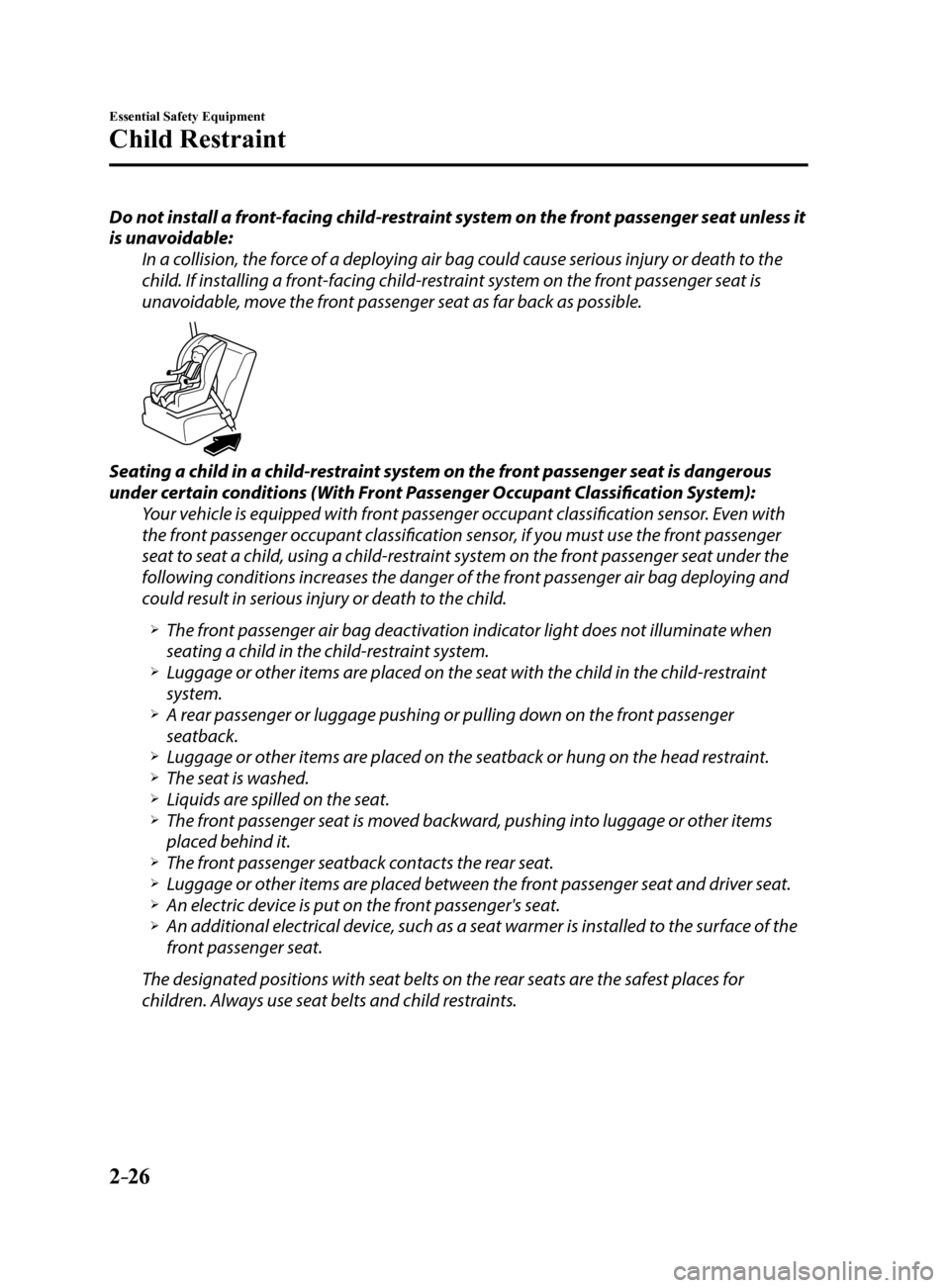
2–26
Essential Safety Equipment
Child Restraint
Do not install a front-facing child-restraint system on the front passenger seat unless it
is unavoidable:In a collision, the force of a deploying air bag could cause serious injury or death to the
child. If installing a front-facing child-restraint system on the front passenger seat is
unavoidable, move the front passenger seat as far back as possible.
Seating a child in a child-restraint system on the front passenger seat is dangerous
under certain conditions (With Front Passenger Occupant Classification System):Your vehicle is equipped with front passenger occupant classification sensor. Even with
the front passenger occupant classification sensor, if you must use the front passenger
seat to seat a child, using a child-restraint system on the front passenger seat under the
following conditions increases the danger of the front passenger air bag deploying and
could result in serious injury or death to the child.
The front passenger air bag deactivation indicator light does not illuminate when
seating a child in the child-restraint system.
Luggage or other items are placed on the seat with the child in the child-restraint
system.
A rear passenger or luggage pushing or pulling down on the front passenger
seatback.
Luggage or other items are placed on the seatback or hung on the head restraint. The seat is washed. Liquids are spilled on the seat. The front passenger seat is moved backward, pushing into luggage or other items
placed behind it.
The front passenger seatback contacts the rear seat. Luggage or other items are placed between the front passenger seat and driver seat. An electric device is put on the front passenger's seat. An additional electrical device, such as a seat warmer is installed to the surface of the
front passenger seat.
The designated positions with seat belts on the rear seats are the safest places for
children. Always use seat belts and child restraints.
Mazda6_8FH2-EA-16F_Edition2.indb 262016/07/07 13:44:14
Page 41 of 578
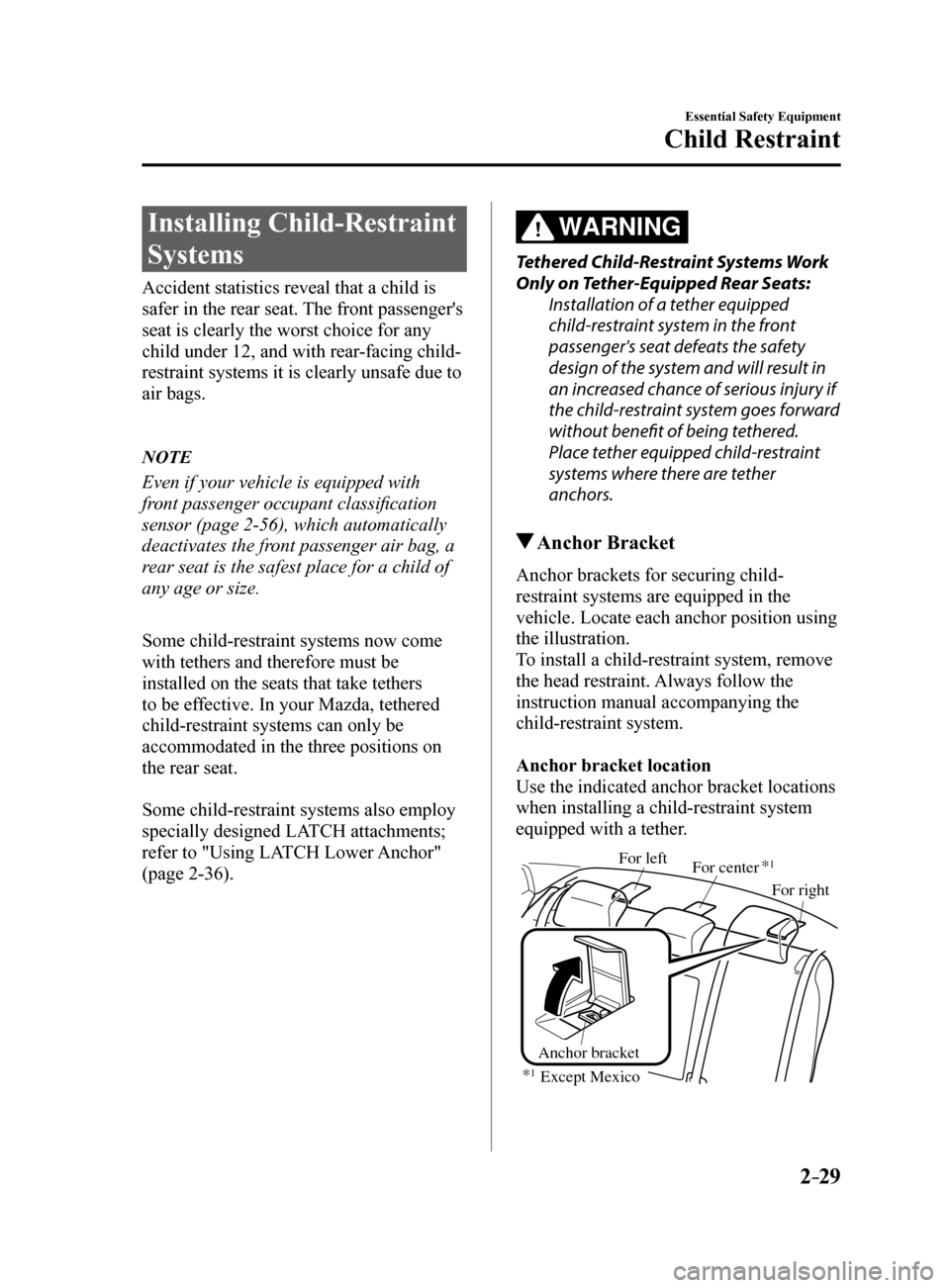
2–29
Essential Safety Equipment
Child Restraint
Installing Child-Restraint
Systems
Accident statistics reveal that a child is
safer in the rear seat. The front passenger's
seat is clearly the worst choice for any
child under 12, and with rear-facing child-
restraint systems it is clearly unsafe due to
air bags.
NOTE
Even if your vehicle is equipped with
front passenger occupant classification
sensor (page 2-56), which automatically
deactivates the front passenger air bag, a
rear seat is the safest place for a child of
any age or size.
Some child-restraint systems now come
with tethers and therefore must be
installed on the seats that take tethers
to be effective. In your Mazda, tethered
child-restraint systems can only be
accommodated in the three positions on
the rear seat.
Some child-restraint systems also employ
specially designed LATCH attachments;
refer to "Using LATCH Lower Anchor"
(page 2-36).
WARNING
Tethered Child-Restraint Systems Work
Only on Tether-Equipped Rear Seats:Installation of a tether equipped
child-restraint system in the front
passenger's seat defeats the safety
design of the system and will result in
an increased chance of serious injury if
the child-restraint system goes forward
without benefit of being tethered.
Place tether equipped child-restraint
systems where there are tether
anchors.
Anchor Bracket
Anchor brackets for securing child-
restraint systems are equipped in the
vehicle. Locate each anchor position using
the illustration.
To install a child-restraint system, remove
the head restraint. Always follow the
instruction manual accompanying the
child-restraint system.
Anchor bracket location
Use the indicated anchor bracket locations
when installing a child-restraint system
equipped with a tether.
Anchor bracket
For left
For right
For center
*
1
*1
Except Mexico
Mazda6_8FH2-EA-16F_Edition2.indb 292016/07/07 13:44:15
Page 44 of 578
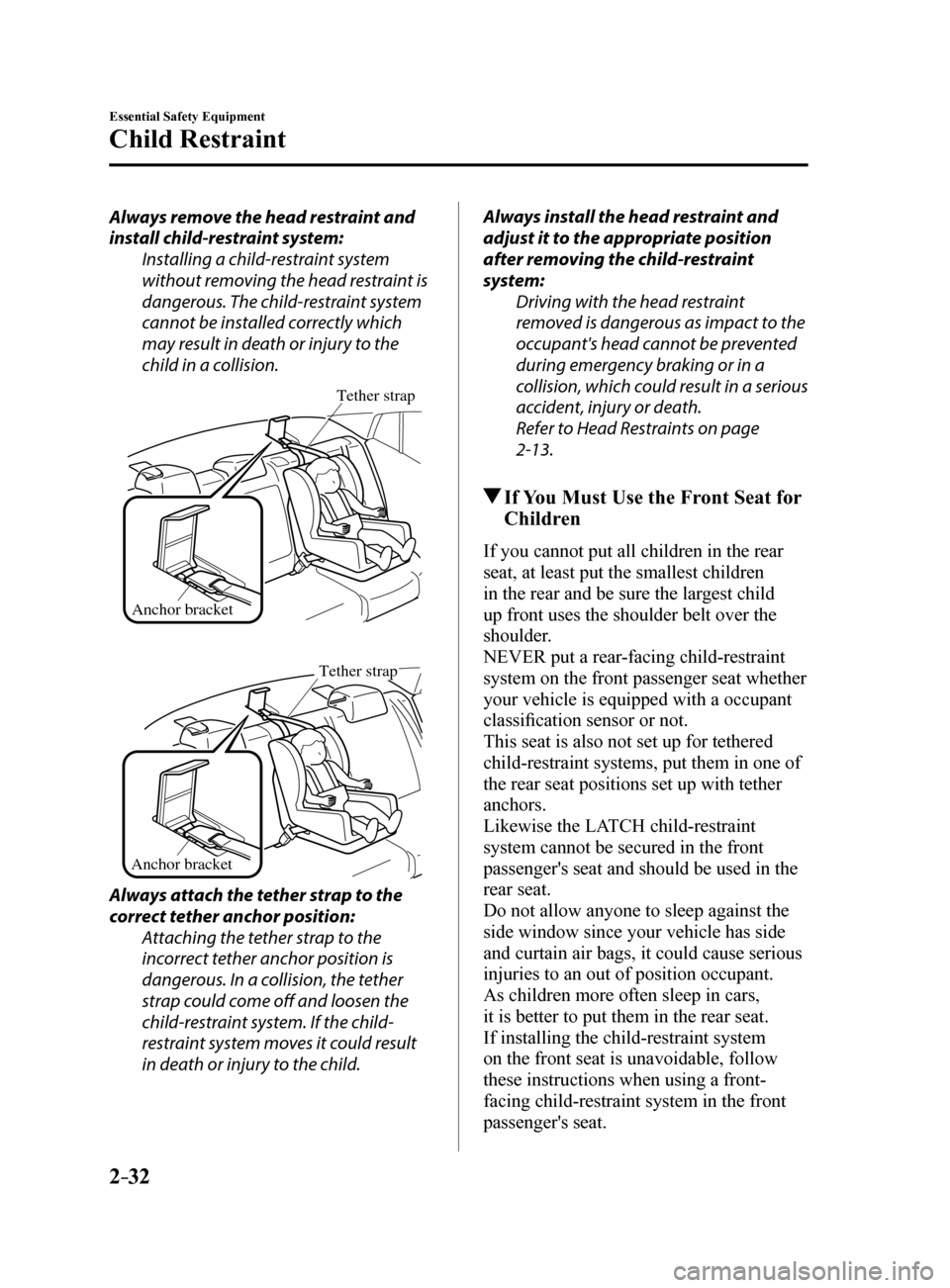
2–32
Essential Safety Equipment
Child Restraint
Always remove the head restraint and
install child-restraint system:Installing a child-restraint system
without removing the head restraint is
dangerous. The child-restraint system
cannot be installed correctly which
may result in death or injury to the
child in a collision.
Anchor bracket
Tether strap
Anchor bracket
Tether strap
Always attach the tether strap to the
correct tether anchor position:Attaching the tether strap to the
incorrect tether anchor position is
dangerous. In a collision, the tether
strap could come off and loosen the
child-restraint system. If the child-
restraint system moves it could result
in death or injury to the child. Always install the head restraint and
adjust it to the appropriate position
after removing the child-restraint
system:
Driving with the head restraint
removed is dangerous as impact to the
occupant's head cannot be prevented
during emergency braking or in a
collision, which could result in a serious
accident, injury or death.
Refer to Head Restraints on page
2-13.
If You Must Use the Front Seat for
Children
If you cannot put all children in the rear
seat, at least put the smallest children
in the rear and be sure the largest child
up front uses the shoulder belt over the
shoulder.
NEVER put a rear-facing child-restraint
system on the front passenger seat whether
your vehicle is equipped with a occupant
classification sensor or not.
This seat is also not set up for tethered
child-restraint systems, put them in one of
the rear seat positions set up with tether
anchors.
Likewise the LATCH child-restraint
system cannot be secured in the front
passenger's seat and should be used in the
rear seat.
Do not allow anyone to sleep against the
side window since your vehicle has side
and curtain air bags, it could cause serious
injuries to an out of position occupant.
As children more often sleep in cars,
it is better to put them in the rear seat.
If installing the child-restraint system
on the front seat is unavoidable, follow
these instructions when using a front-
facing child-restraint system in the front
passenger's seat.
Mazda6_8FH2-EA-16F_Edition2.indb 322016/07/07 13:44:16
Page 52 of 578
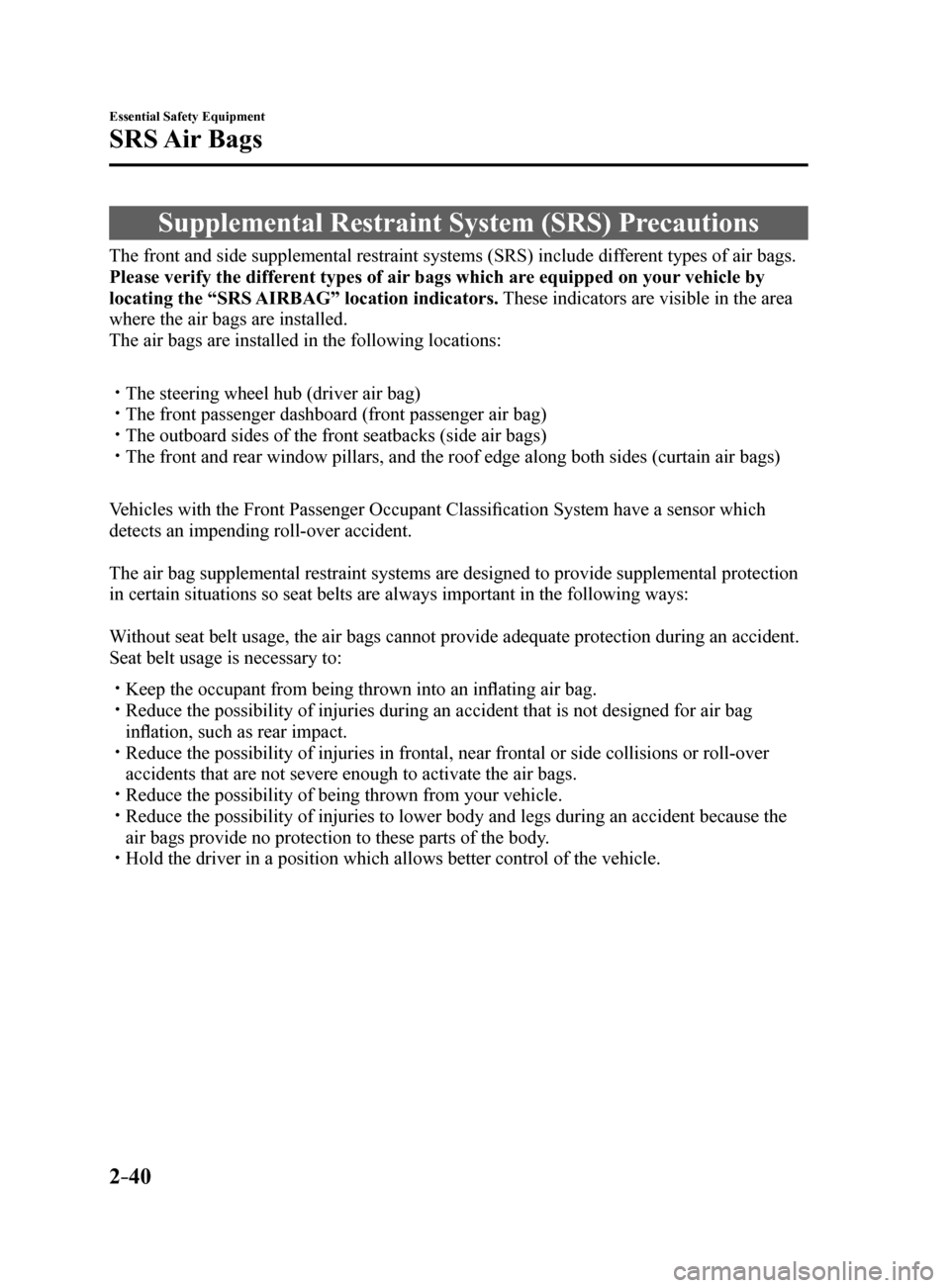
2–40
Essential Safety Equipment
SRS Air Bags
Supplemental Restraint System (SRS) Precautions
The front and side supplemental restraint systems (SRS) include different types of air bags.
Please verify the different types of air bags which are equipped on your vehicle by
locating the “SRS AIRBAG” location indicators. These indicators are visible in the area
where the air bags are installed.
The air bags are installed in the following locations:
The steering wheel hub (driver air bag) The front passenger dashboard (front passenger air bag) The outboard sides of the front seatbacks (side air bags) The front and rear window pillars, and the roof edge along both sides (\
curtain air bags)
Vehicles with the Front Passenger Occupant Classification System have a sensor which
detects an impending roll-over accident.
The air bag supplemental restraint systems are designed to provide suppl\
emental protection
in certain situations so seat belts are always important in the followin\
g ways:
Without seat belt usage, the air bags cannot provide adequate protection during an accident.
Seat belt usage is necessary to:
Keep the occupant from being thrown into an inflating air bag. Reduce the possibility of injuries during an accident that is not designed for air bag
inflation, such as rear impact.
Reduce the possibility of injuries in frontal, near frontal or side collisions or roll-over
accidents that are not severe enough to activate the air bags.
Reduce the possibility of being thrown from your vehicle. Reduce the possibility of injuries to lower body and legs during an accident because the
air bags provide no protection to these parts of the body.
Hold the driver in a position which allows better control of the vehicle\
.
Mazda6_8FH2-EA-16F_Edition2.indb 402016/07/07 13:44:17
Page 55 of 578
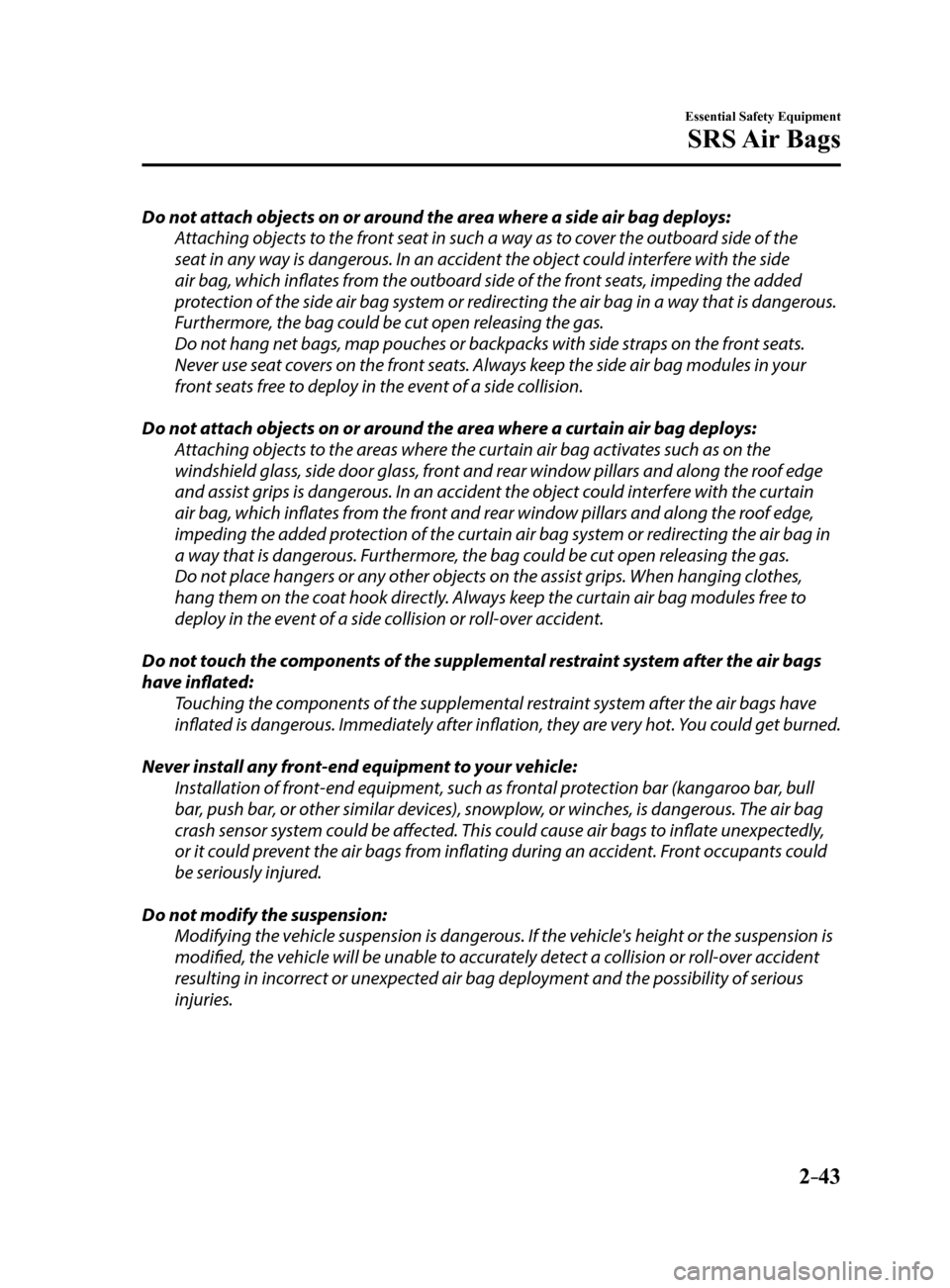
2–43
Essential Safety Equipment
SRS Air Bags
Do not attach objects on or around the area where a side air bag deploys:Attaching objects to the front seat in such a way as to cover the outboard side of the
seat in any way is dangerous. In an accident the object could interfere with the side
air bag, which inflates from the outboard side of the front seats, impeding the added
protection of the side air bag system or redirecting the air bag in a way that is dangerous.
Furthermore, the bag could be cut open releasing the gas.
Do not hang net bags, map pouches or backpacks with side straps on the front seats.
Never use seat covers on the front seats. Always keep the side air bag modules in your
front seats free to deploy in the event of a side collision.
Do not attach objects on or around the area where a curtain air bag deploys: Attaching objects to the areas where the curtain air bag activates such as on the
windshield glass, side door glass, front and rear window pillars and along the roof edge
and assist grips is dangerous. In an accident the object could interfere with the curtain
air bag, which inflates from the front and rear window pillars and along the roof edge,
impeding the added protection of the curtain air bag system or redirecting the air bag in
a way that is dangerous. Furthermore, the bag could be cut open releasing the gas.
Do not place hangers or any other objects on the assist grips. When hanging clothes,
hang them on the coat hook directly. Always keep the curtain air bag modules free to
deploy in the event of a side collision or roll-over accident.
Do not touch the components of the supplemental restraint system after the air bags
have inflated: Touching the components of the supplemental restraint system after the air bags have
inflated is dangerous. Immediately after inflation, they are very hot. You could get burned.
Never install any front-end equipment to your vehicle: Installation of front-end equipment, such as frontal protection bar (kangaroo bar, bull
bar, push bar, or other similar devices), snowplow, or winches, is dangerous. The air bag
crash sensor system could be affected. This could cause air bags to inflate unexpectedly,
or it could prevent the air bags from inflating during an accident. Front occupants could
be seriously injured.
Do not modify the suspension: Modifying the vehicle suspension is dangerous. If the vehicle's height or the suspension is
modified, the vehicle will be unable to accurately detect a collision or roll-over accident
resulting in incorrect or unexpected air bag deployment and the possibility of serious
injuries.
Mazda6_8FH2-EA-16F_Edition2.indb 432016/07/07 13:44:17
Page 56 of 578
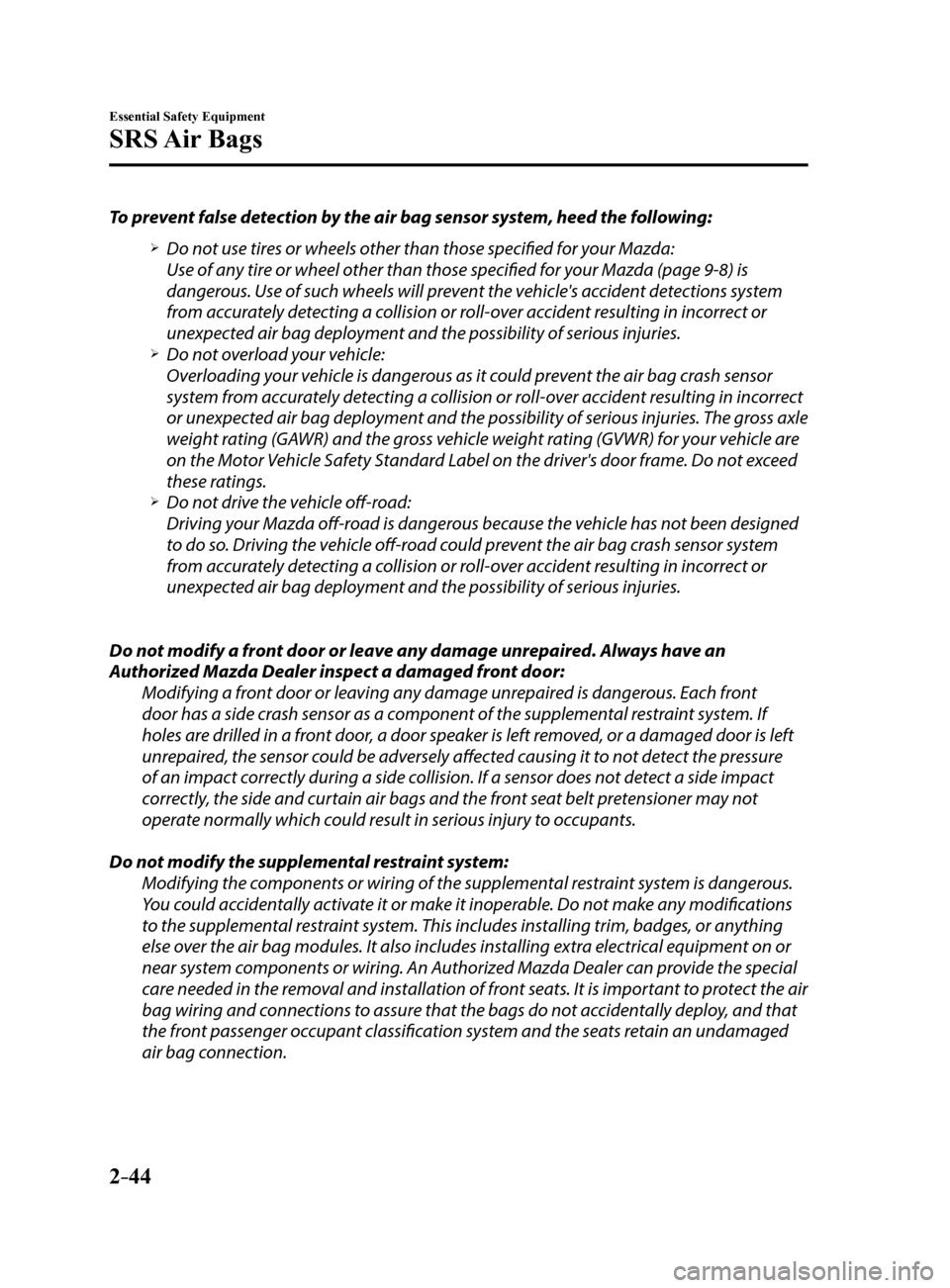
2–44
Essential Safety Equipment
SRS Air Bags
To prevent false detection by the air bag sensor system, heed the following:
Do not use tires or wheels other than those specified for your Mazda:
Use of any tire or wheel other than those specified for your Mazda (page 9-8) is
dangerous. Use of such wheels will prevent the vehicle's accident detections system
from accurately detecting a collision or roll-over accident resulting in incorrect or
unexpected air bag deployment and the possibility of serious injuries.
Do not overload your vehicle:
Overloading your vehicle is dangerous as it could prevent the air bag crash sensor
system from accurately detecting a collision or roll-over accident resulting in incorrect
or unexpected air bag deployment and the possibility of serious injuries. The gross axle
weight rating (GAWR) and the gross vehicle weight rating (GVWR) for your vehicle are
on the Motor Vehicle Safety Standard Label on the driver's door frame. Do not exceed
these ratings.
Do not drive the vehicle off-road:
Driving your Mazda off-road is dangerous because the vehicle has not been designed
to do so. Driving the vehicle off-road could prevent the air bag crash sensor system
from accurately detecting a collision or roll-over accident resulting in incorrect or
unexpected air bag deployment and the possibility of serious injuries.
Do not modify a front door or leave any damage unrepaired. Always have an
Authorized Mazda Dealer inspect a damaged front door: Modifying a front door or leaving any damage unrepaired is dangerous. Each front
door has a side crash sensor as a component of the supplemental restraint system. If
holes are drilled in a front door, a door speaker is left removed, or a damaged door is left
unrepaired, the sensor could be adversely affected causing it to not detect the pressure
of an impact correctly during a side collision. If a sensor does not detect a side impact
correctly, the side and curtain air bags and the front seat belt pretensioner may not
operate normally which could result in serious injury to occupants.
Do not modify the supplemental restraint system: Modifying the components or wiring of the supplemental restraint system is dangerous.
You could accidentally activate it or make it inoperable. Do not make any modifications
to the supplemental restraint system. This includes installing trim, badges, or anything
else over the air bag modules. It also includes installing extra electrical equipment on or
near system components or wiring. An Authorized Mazda Dealer can provide the special
care needed in the removal and installation of front seats. It is important to protect the air
bag wiring and connections to assure that the bags do not accidentally deploy, and that
the front passenger occupant classification system and the seats retain an undamaged
air bag connection.
Mazda6_8FH2-EA-16F_Edition2.indb 442016/07/07 13:44:17
Page 57 of 578
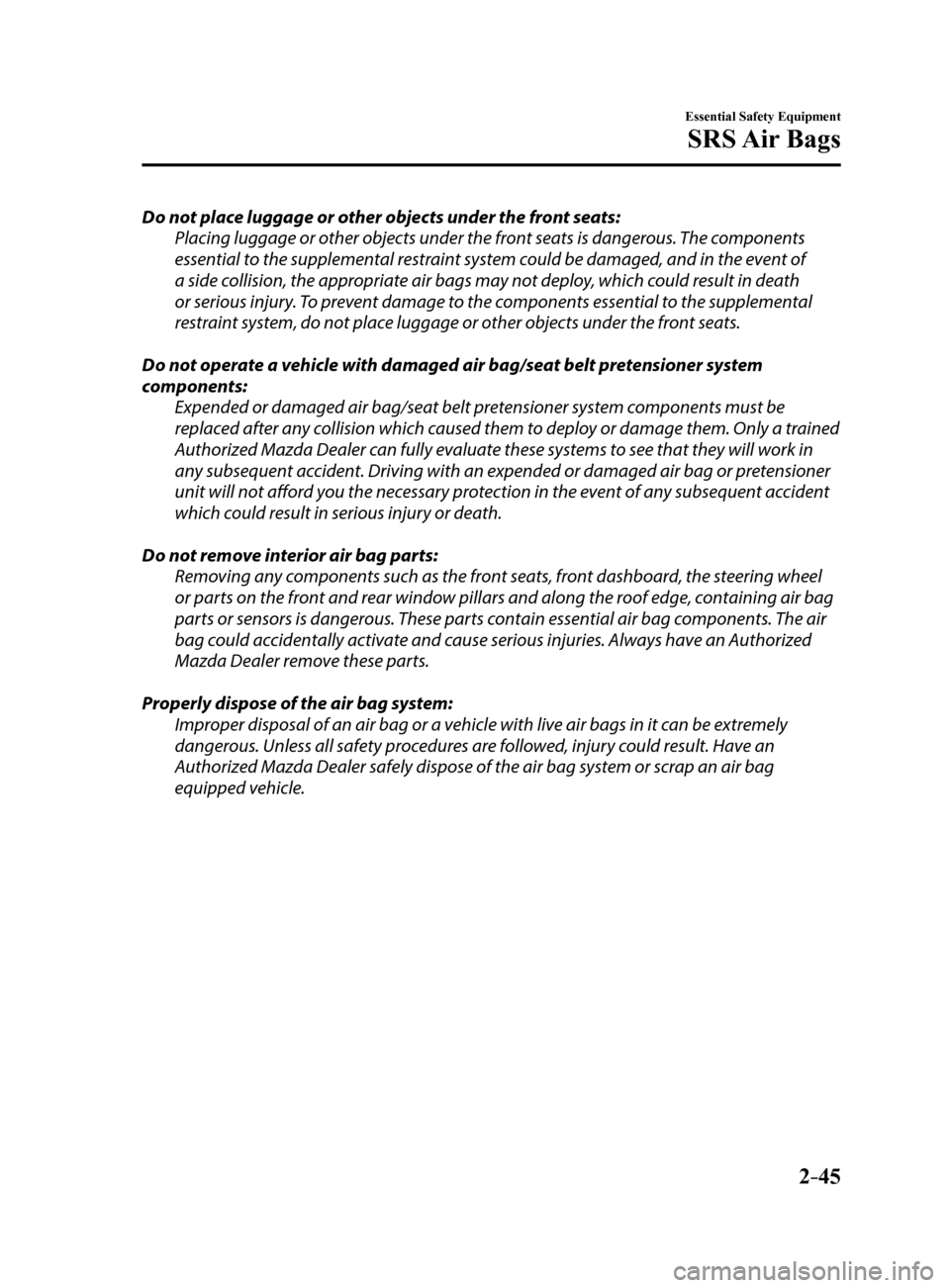
2–45
Essential Safety Equipment
SRS Air Bags
Do not place luggage or other objects under the front seats:Placing luggage or other objects under the front seats is dangerous. The components
essential to the supplemental restraint system could be damaged, and in the event of
a side collision, the appropriate air bags may not deploy, which could result in death
or serious injury. To prevent damage to the components essential to the supplemental
restraint system, do not place luggage or other objects under the front seats.
Do not operate a vehicle with damaged air bag/seat belt pretensioner system
components: Expended or damaged air bag/seat belt pretensioner system components must be
replaced after any collision which caused them to deploy or damage them. Only a trained
Authorized Mazda Dealer can fully evaluate these systems to see that they will work in
any subsequent accident. Driving with an expended or damaged air bag or pretensioner
unit will not afford you the necessary protection in the event of any subsequent accident
which could result in serious injury or death.
Do not remove interior air bag parts: Removing any components such as the front seats, front dashboard, the steering wheel
or parts on the front and rear window pillars and along the roof edge, containing air bag
parts or sensors is dangerous. These parts contain essential air bag components. The air
bag could accidentally activate and cause serious injuries. Always have an Authorized
Mazda Dealer remove these parts.
Properly dispose of the air bag system: Improper disposal of an air bag or a vehicle with live air bags in it can be extremely
dangerous. Unless all safety procedures are followed, injury could result. Have an
Authorized Mazda Dealer safely dispose of the air bag system or scrap an air bag
equipped vehicle.
Mazda6_8FH2-EA-16F_Edition2.indb 452016/07/07 13:44:17
Page 60 of 578
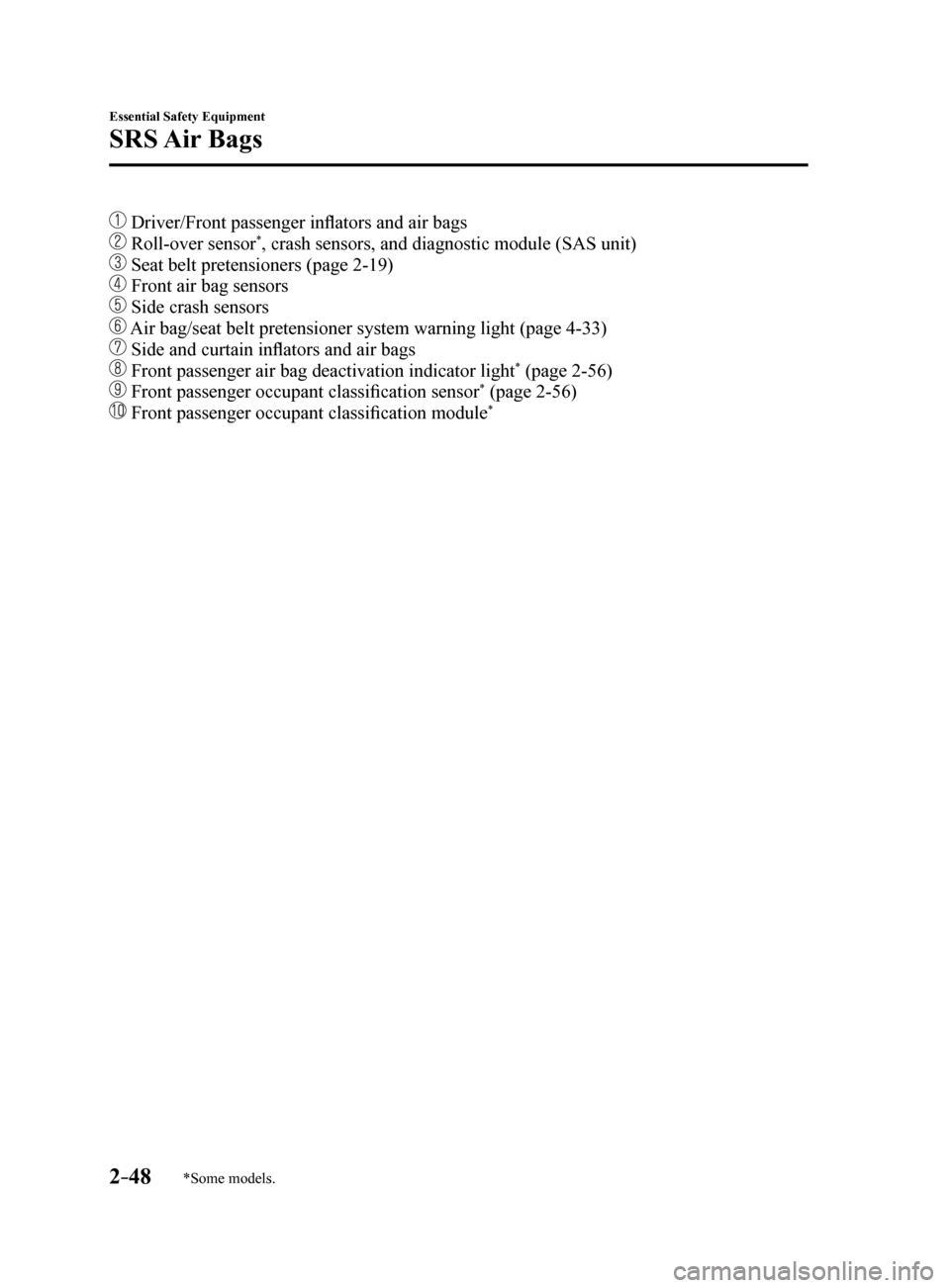
2–48
Essential Safety Equipment
SRS Air Bags
*Some models.
Driver/Front passenger inflators and air bags
Roll-over sensor*, crash sensors, and diagnostic module (SAS unit)
Seat belt pretensioners (page 2-19)
Front air bag sensors
Side crash sensors
Air bag/seat belt pretensioner system warning light (page 4-33)
Side and curtain inflators and air bags
Front passenger air bag deactivation indicator light* (page 2-56)
Front passenger occupant classification sensor* (page 2-56)
Front passenger occupant classification module*
Mazda6_8FH2-EA-16F_Edition2.indb 482016/07/07 13:44:18